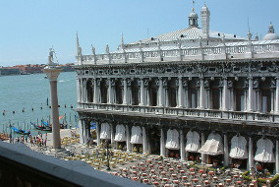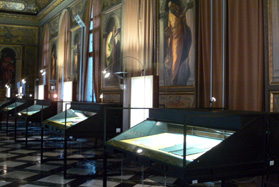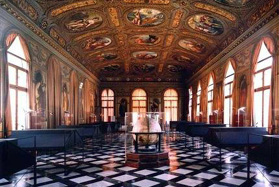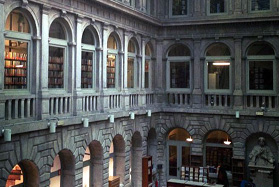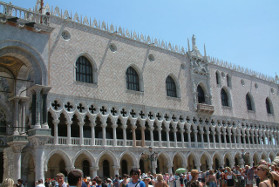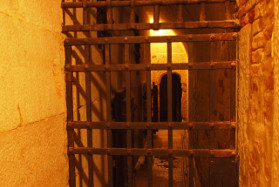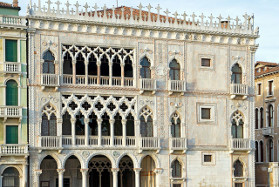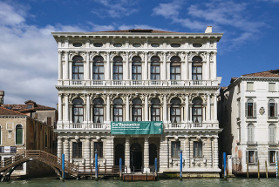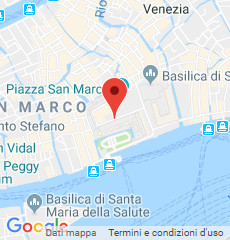Biblioteca Marciana
The ticket allows you to visit also the Doge's Palace, the Correr Museum and the Archaeological Museum.
A bit of history of the Biblioteca Marciana
The Biblioteca Marciana, also known as the Sansovino Library, had its origins thanks to the sponsorship of Cardinal Bessarion, who in 1468 donated his collection of about 750 codes to which he later added 250 manuscripts and printed works.
Venice accepted the gift and began to consider a drawing made by Francesco Petrarca, a century earlier, of a "public library" in Venice. The Venetian State promised to create a building worthy of the donation but it was not possible to start the construction of the library until 1537 using the designs by Jacopo Sansovino who was able to harmonize the most noble classical style of the Renaissance with the picturesque Venetian atmosphere.
After the relocation of the library to the new building, it began to be enriched thanks to donations and legacies. This increase was mainly due to transfers from the libraries of some monasteries, as well as to the obligation imposed on the printing press to deliver a copy of each published book, according to the Venetian law of 1603. After the fall of the Republic of Venice, the library was further enriched as a result of religious entities abolished during the Napoleonic period in which the libraries were transferred to the Biblioteca Marciana.
What is the Biblioteca Marciana nowadays?
At present, the The Biblioteca Marciana depends on the Ministry of National Heritage and Culture and has one million volumes, 13,000 manuscripts, more than 2800 incunables. The building of the Library is a true work of art beginning with the decoration of its halls, its sculptures and its coffered ceilings. This library is rich in terms of Greek culture, the history of Venice and Venetian editions, and has been strengthened in this century by large donations. The Library is currently at the service of scholars from all over the world playing an important role in the cultural life of the city of Venice.
Curiosities of the Biblioteca Marciana
Did you know that the monumental rooms of the Biblioteca Marciana offer the opportunity to experience the beauty of the old St. Mark Library? This majestic library has an extraordinary dimensions, a vestibule later transformed into a public sanctuary, the main hall used for the library with a rich decoration composed by a historical and artistic trajectory of great interest and value. In addition, the museum currently houses exhibitions and events.
Did you know that the idea of building a public library in Venice was born for the first time during the stay of Francesco Petrarca in the city of canals? In 1362 Petrarch decided to donate his books to the Republic to form part of the nucleus of a larger collection that remained open to scholars and lovers of literature and culture.
Why visit the Biblioteca Marciana?
The Biblioteca Marciana (Marciana National Library) is one of the museums that we can´t miss in Venice. The Biblioteca Marciana is a work of Jacopo Sansovino and was built and decorated to become home to the Greek and Latin manuscripts that were donated in 1468 to the Republic of Venice by Cardinal Bessarion. Some of these important manuscripts are Breviario Grimani of 5th century and the map of the world of Fra Mauro, in addition to the first editions of Aldo Manuzio. The lobby on the first floor has an impressive ceiling, Titian (Tiziano Vecelli) painting and called "La Sapienza" (“knowledge”), on the ceiling of the hall you can admire twenty-one portraits, works by seven artists selected by Tiziano and Sansovino, three of the best known are from Paolo Veronese and on the walls are portraits of philosophers, works by Tintoretto and Veronese.
How to visit the Marciana Library?
To visit the magnificent monumental rooms of the Marciana Library, you can buy the Venice Museum Pass online or the entrance to the St. Mark's Square Museums.
Other attractions in the area
The Correr Museum, the Biblioteca Marciana and the Archaeological Museum are located in St. Mark Square (Piazza San Marco) in the New Attorneys' Offices. These three museums are part of the same complex, so it is possible to visit all three with a unique entrance.
In the Correr Museum you will be able to appreciate the collection of the maximum neoclassic exponent of the sculpture Antonio Canova, as well as the collection of old art where important works of the Venetian Cinquecento are exhibited.
The Archaeological Museum originated with the collection of Cardinal Domenico Grimani, who at his death donated his collection of ancient objects to the Republic of Venice.
You may be interested in:
Borghese Gallery Tickets (Rome), Duomo (Milan) or Accademia (Florence).
Customers who booked this museum also booked:
Useful Information
Open from Monday to Thursday from 8.20 am to 7.00 pm, on Friday, Saturday, December 24th and 31st from 8.20 am to 1.30 pm
Closed Sunday, January 1st and 6th, April 25th, May 1st, June 2nd, August 15th, November 1st and 21st, December 8th, 25th and 26th.

+39 055713655
Reach the museums in total comfort with our transfer service!

TRANSFER SERVICE
Book Now




